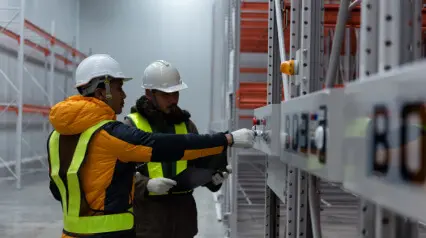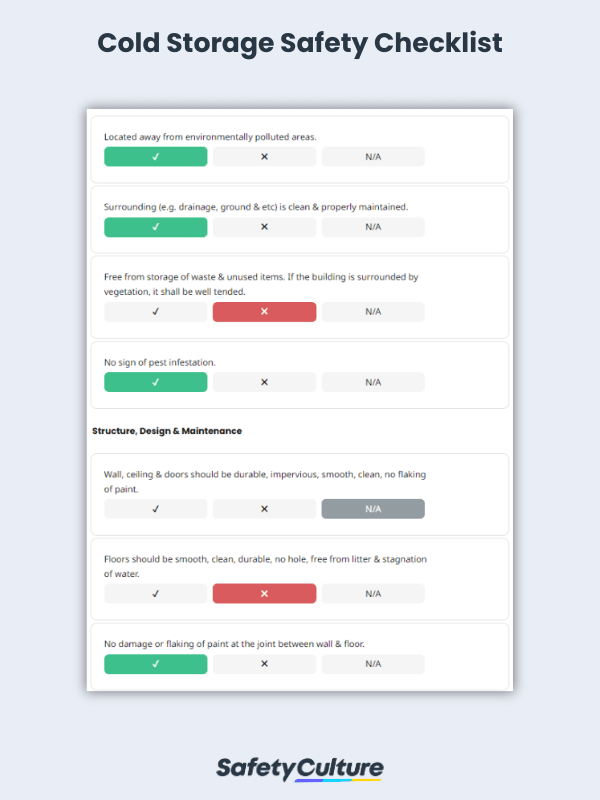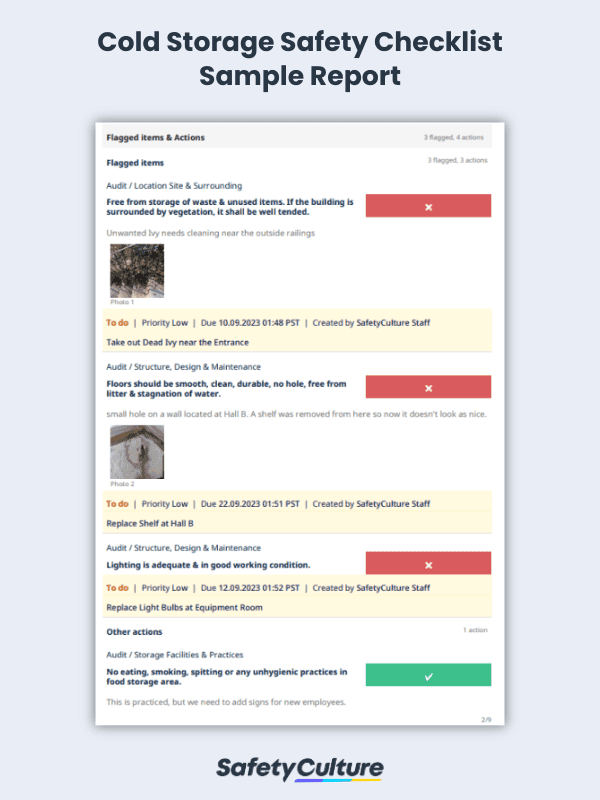What is a Cold Storage Safety Checklist?
A cold storage safety checklist is a systematic guide that outlines the necessary precautions and steps to ensure the safe operation of cold storage facilities. This checklist is designed to make sure that a safety audit is properly conducted in order to minimize risks, safeguard personnel, and integrity of stored goods within the refrigerated environment.
Importance and Benefits
A cold storage safety checklist is essential for ensuring the secure functioning of cold storage facilities. By conducting equipment inspections, monitoring temperature controls, and reviewing emergency protocols, it helps prevent accidents, spoilage, and costly downtime. It’s essential to understand the risks involved in cold storage to appreciate the necessity of a safety checklist.
- Temperature Fluctuations – Maintaining consistent temperatures within a cold storage facility is paramount. Fluctuations can lead to spoilage of goods, affecting both quality and safety. Our checklist addresses this critical concern.
- Moisture and Condensation – Cold storage environments often have high humidity levels, which can result in moisture and condensation buildup. These conditions can lead to product damage and even mold growth, necessitating vigilant moisture control.
- Contamination Risks – The risk of contamination is ever-present in cold storage. Contaminants can compromise the integrity of stored items, posing health risks to consumers. Our checklist emphasizes measures to mitigate this risk.
- Electrical Hazards – Electrical systems are integral to cold storage operations. However, they also pose a significant hazard if not maintained correctly. Fire and electrical safety are crucial components of our checklist.
- Fire Risks – Cold storage facilities can be vulnerable to fires due to various factors, including faulty electrical equipment and insulation materials. Fire safety protocols are an indispensable part of our checklist for cold storage safety.
What to Include in a Cold Storage Safety Checklist
Cold storage safety checklists may vary depending on the location of the cold storage and its involved equipment. But a cold storage safety checklist should ideally include and cover the following :
- Temperature Control – Regular temperature monitoring, Alarms for temperature deviations, Backup cooling systems
- Ventilation and Air Quality – Adequate ventilation to prevent condensation, Air quality control to minimize contaminants
- Fire Safety – Fire detection and suppression systems, Employee training for fire response
- Hygiene and Sanitation – Cleaning and disinfection schedules, Pest control measures
- Structural Integrity – Routine inspection of facility structure, Repairs and maintenance as needed
- Emergency Response – Emergency evacuation plans, Communication systems for emergencies
- Security Measures – Access control to prevent unauthorized entry, Surveillance systems for enhanced security
A Step-by-Step Guide on How to Utilize the Checklist
Implementing a cold storage safety checklist involves a methodical approach. A breakdown of the steps to ensure its effective utilization are as follows :
1. Site & Surrounding
Begin by assessing the site and its surroundings. Ensure that the location is suitable for cold storage, with minimal exposure to environmental hazards.
2. Structure, Design, & Maintenance
Evaluate the facility’s structure and design. Are there any structural vulnerabilities or design flaws that need attention? Regular maintenance is key to structural integrity.
3. Storage Facilities & Practices
Examine the storage units and practices. Ensure that goods are stored correctly, and temperature control is maintained within the desired range.
4. Pest Control & Waste Disposal
Implement robust pest control measures to prevent infestations. Proper waste disposal practices are essential to maintain cleanliness.
5. Staff Facilities
Consider the welfare of your employees. Adequate break and restroom facilities contribute to a conducive working environment.
6. Dispatch & Transport
Review the dispatch and transportation procedures. Ensure that products are handled with care during loading and unloading.
7. Documentation & Records
Maintain meticulous records of temperature logs, inspections, and any incidents. These records are invaluable for audits and continuous improvement.
Frequently Asked Questions (FAQs)
A general guideline when conducting cold storage inspections should be done at least once a week, with more extensive inspections performed on a monthly or quarterly basis. However, the frequency of inspections can vary depending on factors such as the type of products stored, the size of the facility, and local regulations.
Employee training for cold storage safety should cover topics like hazard awareness, temperature control, proper use of personal protective equipment, and emergency procedures. It’s crucial to emphasize safe handling practices, hygiene standards, and compliance with regulations.
Cold storage safety checks should be conducted by trained personnel who have a deep understanding of the specific hazards and protocols associated with cold storage environments. Typically, this responsibility falls on facility managers or designated safety officers who oversee the daily operations. These individuals should have the expertise to identify potential risks, assess equipment functionality, and ensure compliance with safety regulations.




